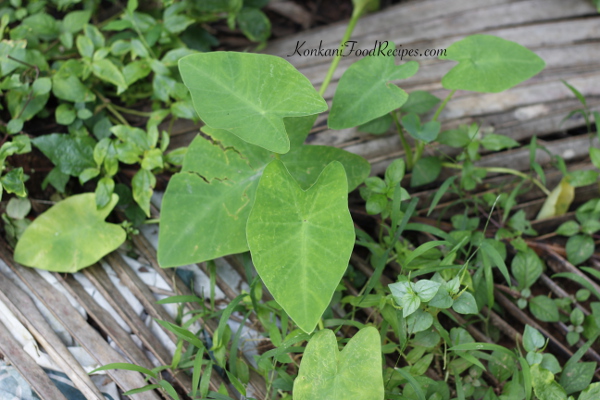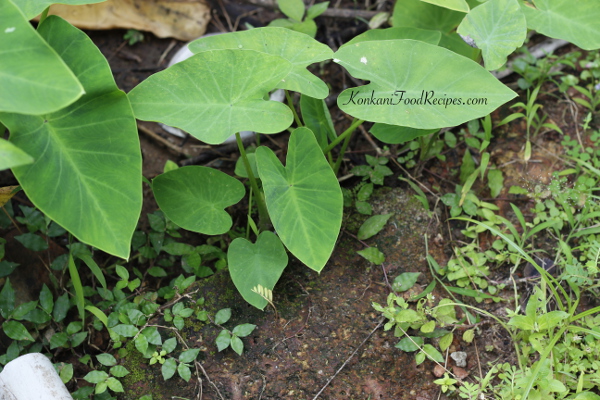Colocasia Leaves Curry (Alvati)

Alvati is a Konkani cuisine rainy season delicacy. A delicious curry prepared using colocasia leaves. This colocasia leaves curry is spicy, tangy, silky smooth & delicious. Tender colocasia leaves in this curry are well cooked along in a spicy coconut masala until they're super soft & 'just melt in your mouth'.
Alvati is made in many ways. The basic recipe for alvati includes cooking colocasia leaves well with hog plums/bilimbi/star fruit so that they the calcium oxalate crystals present in colocasia leaves breakdown. Not using enough of them or not cooking colocasia leaves enough causes itchiness in your mouth & throat. You then cook well-cooked colocasia leaves with green chillies, ginger, a spicy coconut masala and then finish off with coconut oil or a seasoning (garlic or mustard-curry leaves seasoning).
You can make alvati using green gram, jackfruit seeds, fresh bamboo shoots, chickpeas etc. My mom adds a handful of green gram to this dish as they have a cooling effect on our body. However, you can choose to skip them all of them & use only colocasia leaves.
What the curry looks like:
Type of colocasia leaves best suited for making this curry:
To make an amazing curry, the choice of colocasia leaves is VERY important. How great the curry turns out to be, totally depends on the colocasia leaves you use. To make delicious, melt in your mouth curry, USE TENDER MOST COLOCASIA LEAVES. They cook fast & cook well. The curry then is an absolute delight to eat. If you use mature colocasia leaves, they don't cook well & get soft as much as tender colocasia leaves do.
Also, the variety of colocasia leaves you use, make a huge difference. For a great curry, you need to use the right variety of colocasia leaves. Tere paan, a variety of colocasia that grows abundantly only in monsoon is best suited to make this dish. The leaves of this colocasia variety are super soft & tender. They cook fast & cook well unlike other varieties of colocasia.
Their scientific name is Colocasia esculenta & tere paan is the Konkani name. These colocasia plants, leaves look like below:
As rainy season comes to an end, scorching sun dries out colocasia leaves of this variety. They mature early, turn yellow in colour fast and can't be used to make this dish.
You can use other varieties of colocasia to make this curry, but they make a huge difference to the end dish. Tere paan variety colocasia leaves 'just melts in your mouth' after cooking them well unlike the other varieties of colocasia leaves that remain a little fibery even after proper cooking. If you can't find tere paan variety colocasia leaves, then use tender most leaves of any other variety of colocasia.
Alvati Recipe:
Here goes a simple recipe to make alvati.
Ingredients:
- 15-20 tender most colocasia leaves with their stems
- 2 green chillies
- 1-inch fresh ginger
- 1/2 cup grated coconut
- 2 dried red chillies
- 1 lemon sized tamarind/3 hog plums/3 bilimbis/3 star fruits
- Salt to taste
- 3 tablespoons of coconut oil
- 1/2 cup green gram (optional)
Serves: 2
Preparation Time: 40 minutes
Method of Preparation:
1. Soak green gram for about half an hour so that it cooks well along with colocasia leaves. Soaking them for longer ensures they cook well fast.
2. Choose tender most colocasia leaves so that they cook well. Wash them well.
3. Chop off the stems of colocasia leaves. Peel outer layer of colocasia stems if there is any. Tender most stems won't have any to be peeled. Chop them finely and keep them aside.
4. Devein the leaves if they have thick veins (thick veins when are left out can cause itching). Then finely chop the leaves.
Tender most leaves won't need deveining as they wouldn't have developed thick veins.
5. Cook finely chopped colocasia leaves, colocasia stems with salt, washed hog plums/bilimbi/star fruits for 2 whistles in a pressure cooker with half a cup of water.
6. Cook green gram in a pressure cooker with 3/4 cup of water for 2-4 whistles or until they are well cooked.
7. Meanwhile, fry dried red chillies with few drops of oil for 2 minutes to remove its rawness. Once they cool, grind them along with grated coconut into a smooth paste using 1/2 cup of water and keep it aside.
If you haven't used hog plums/bilimbi/star fruits earlier, then use tamarind while grinding the masala.
8. Once the pressure of the cooker is released, transfer all the cooked ingredients into a cooking vessel along with the water used to cook them.
9. Transfer the ground masla into the cooking vessel and mix well. This curry is thick in consistency so do not add extra water.
10. Add in finely chopped green chillies, peeled, chopped ginger to the cooking vessel.
11. Mix well and bring them to boil. Check and adjust salt. Simmer for few minutes.
12. Once the rawness of the masala goes off and the ingredients blend in well into a nice curry, remove it off heat.
13. Add coconut oil and mix well.
14. Serve the curry hot with a bowl of steaming hot rice & enjoy!
Side Note:
1. If you don't cook colocasia leaves well and with enough tamarind/hog plum/bilimbi/star fruit then it'll itch your mouth and throat due to calcium oxalate crystals present in colocasia.
2. If your hands itch, apply lemon juice/tamarind water/oil to your hands. To prevent itching apply them while chopping the colocasia leaves and stem. After chopping wash your hands well using soap and hot water.
Variations to this curry:
1. You can choose to season the curry with mustard seeds and curry leaves instead of adding just coconut oil in the end.
2. To the above recipe, use 2-3 extra dried red chillies while grinding the masala. Skip the green chillies and the ginger. Season the curry with garlic for an amazing flavour. Fry 10-12 garlic cloves in oil until they start to brown and add this seasoning to the curry. This version of the curry tastes good too.
3. You can add cooked jackfruit seeds, cooked fresh bamboo shoots to this curry and enjoy! Fresh bamboo shoots add a nice crunch to the otherwise smooth curry. Jackfruit seeds add a nice texture to the smooth curry.
This curry is a must as part of the spread on Anantha Nopi day. This day usually falls at the end of the rainy season. This colocasia leaves curry is a must for lunch on this day as you may not get tender most colocasia leaves (tere paan) after this day for an entire year.
Other colocasia dishes:
Steamed Colocasia Leaves Pinwheels (Pathrode or pathrado or pathrodo)
Colocasia Leaves Pinwheels Stir Fry (Pathrode Upakari, Pathrade Usli)
Colocasia Leaves Gojju (Alva Panna Gojju)
Shallow Fried Leftover Pathrado (Pathrade Fry)
Tags: alvati, colocasia leaves curry, Konkani recipe, Konkani cuisine, Konkani food, alva paan, GSB Konkani recipe, vegan, vegetarian recipe, South Canara Konkani recipe, Konkani cooking, GSB Konkani cuisine.


Tweet